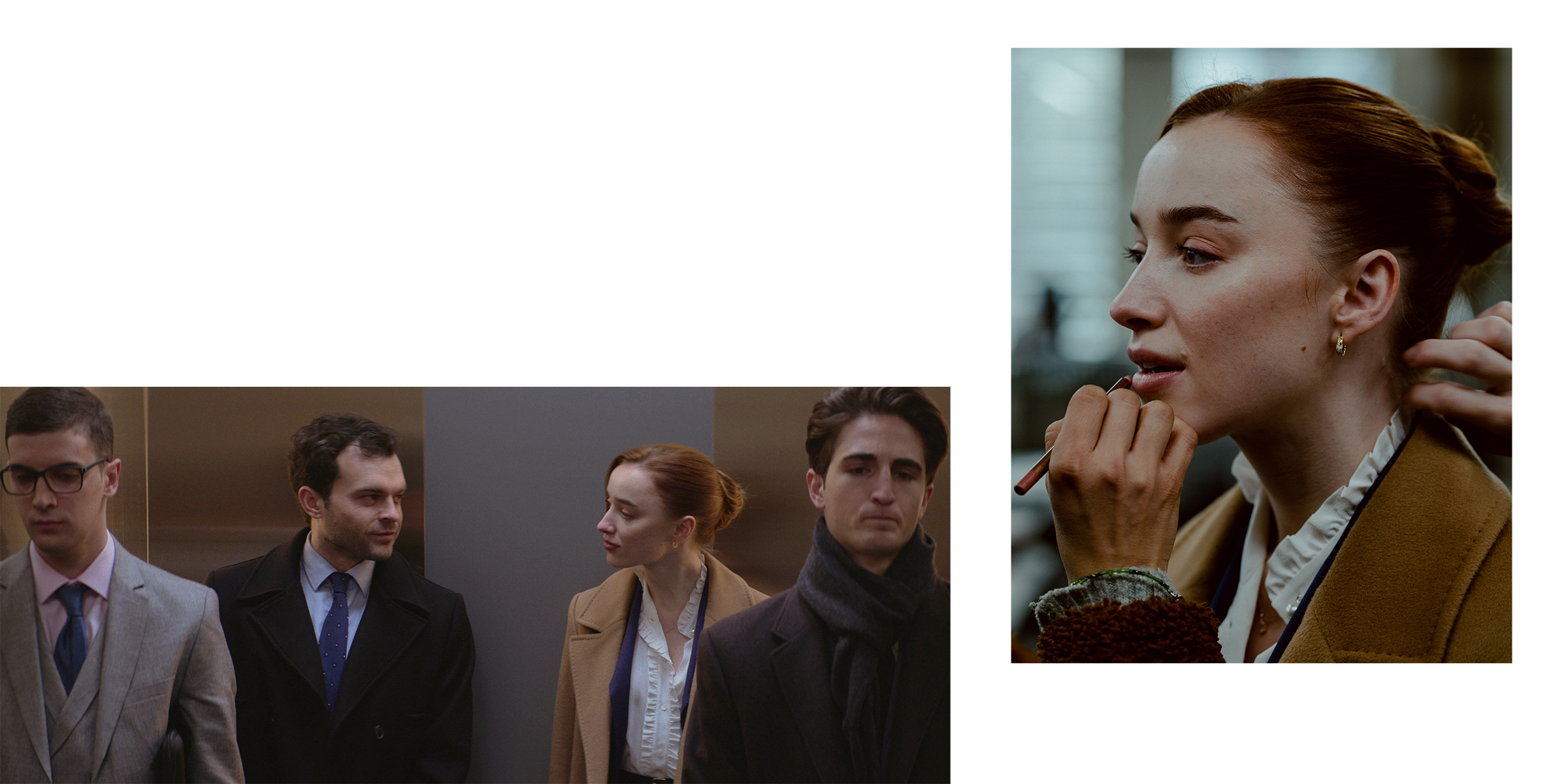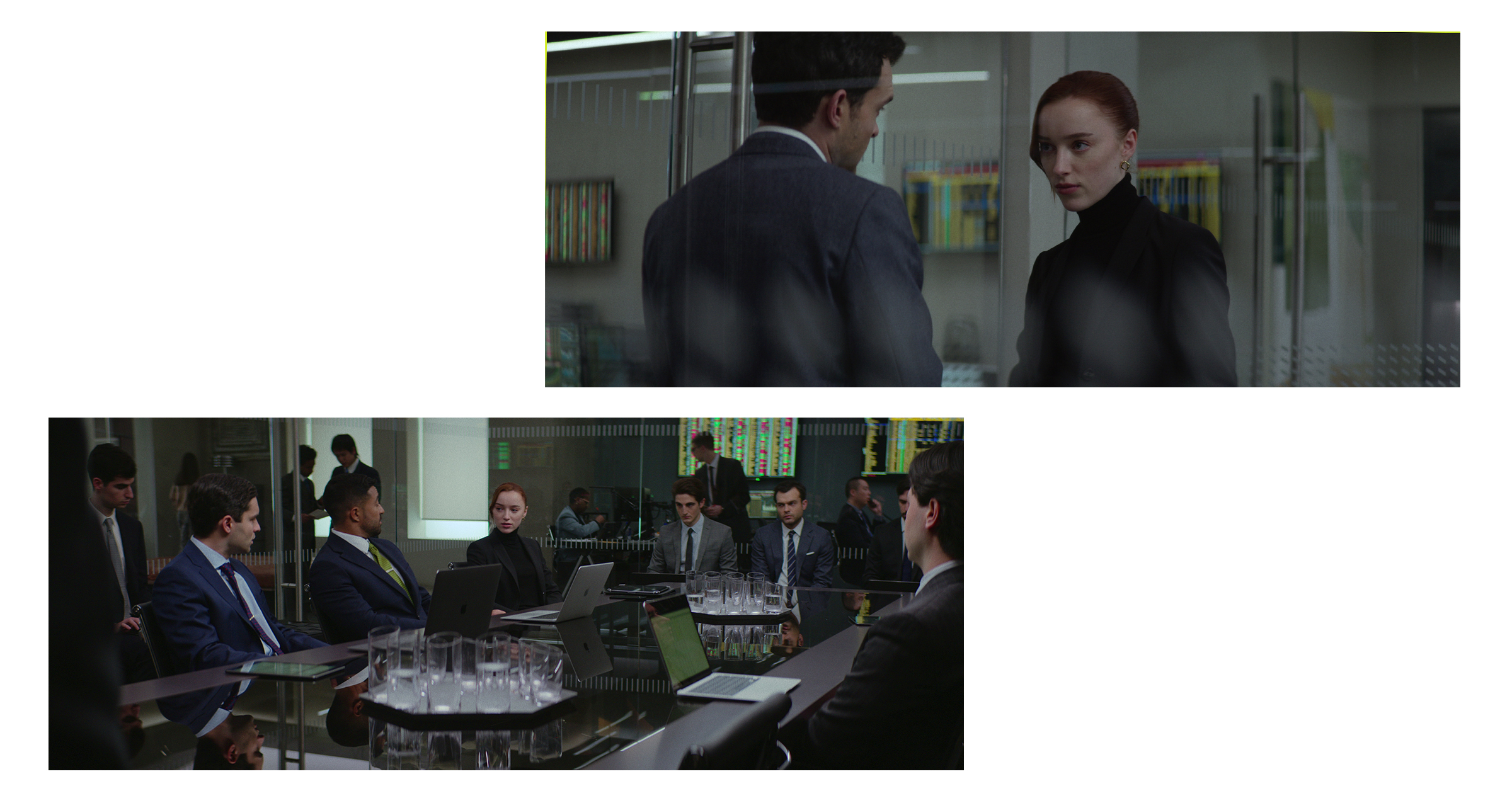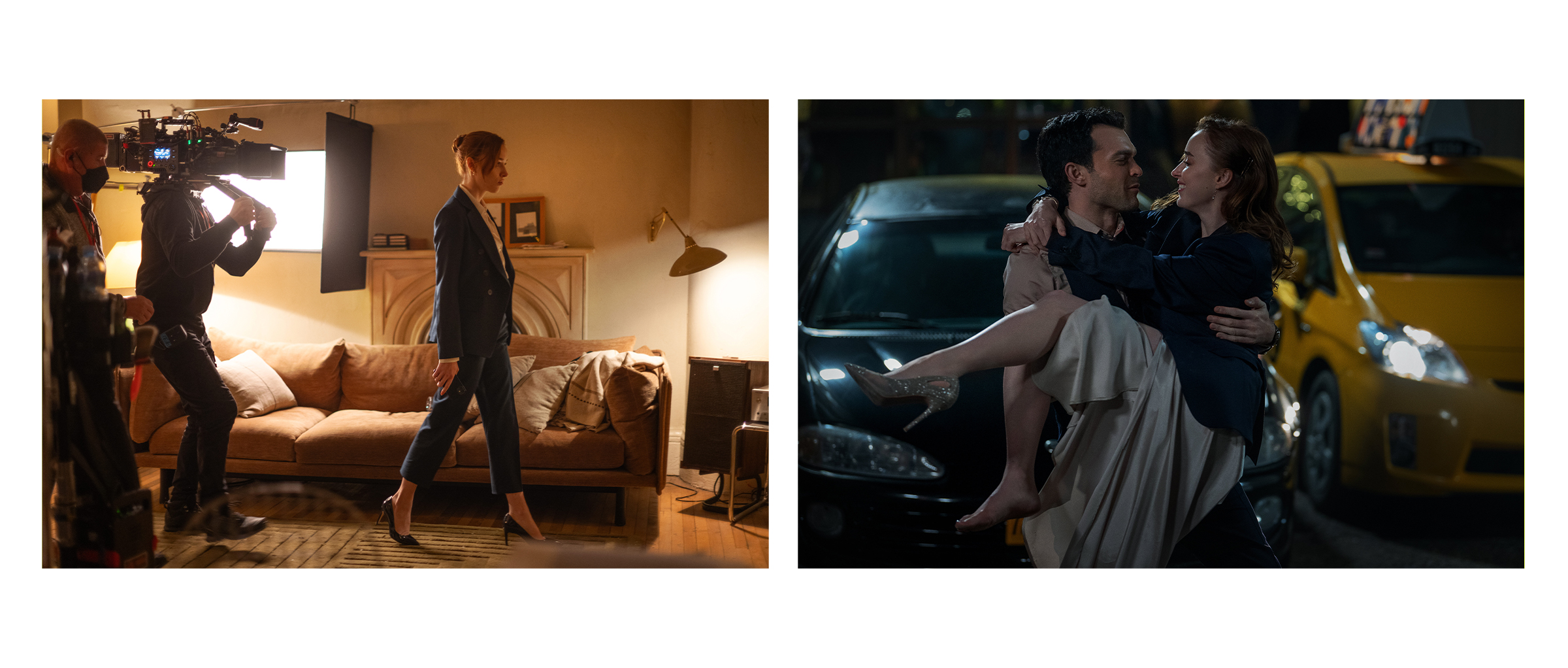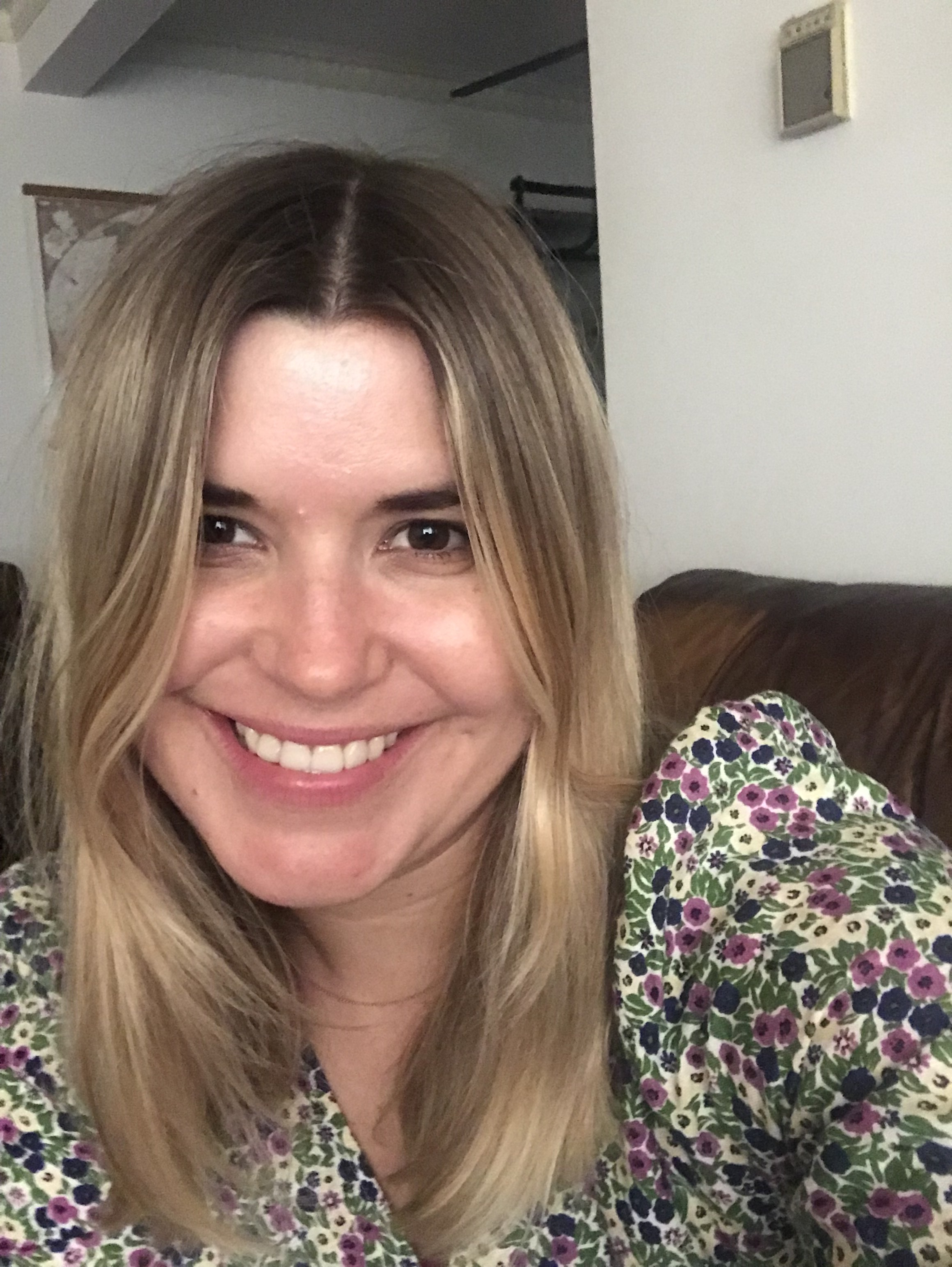Netflix's Fair Play Is a Master Class in Perfecting the Corporate Aesthetic


The corporate aesthetic just might be our version of the Roman Empire as of late. Ever since the likes of Prada, Saint Laurent, and Victoria Beckham showed modern versions of 9-to-5 dressing on the fall/winter 2023 runways, we’ve been consumed with the idea of workwear and its many forms. We love a great structured blazer, pinstripes, and a sleek leather pencil skirt as much as the next fashion-conscious corporate person, but more than that, there’s something so interesting about how these pieces can be styled together, the contrasts at play, and the message certain silhouettes can communicate. It’s this kind of attention to detail that makes the business attire in the fantastic film Fair Play as captivating as the story itself.
Sex, power, and ego are on a collision course in this thrilling workplace drama starring Phoebe Dynevor and Alden Ehrenreich. Now streaming on Netflix, the film follows Emily and Luke, a newly engaged couple who work at the same cutthroat financial firm. Just as everything seems to be falling into place for the lovers, Emily lands an unexpected promotion, causing their power dynamic to suddenly shift and sending their relationship into turmoil. In this ruthless story of gender dynamics, writer-director Chloe Domont begs the question, What is the true price of ambition and success?
While Wall Street and hedge funds don’t exactly scream fashion with a capital F, dressing these characters was an exciting prospect for costume designer Kate Forbes. It was an opportunity for her to take an otherwise timeless and prescribed look and imbue it with a bit of romance as a nod to the film’s larger themes of power and gender. Diving deeper into the costumes, we spoke with Forbes about striking the right balance between masculine and feminine, where Emily would have likely shopped, and why color is the key to any workwear look.

What about the Fair Play script felt like an exciting challenge from a costume design perspective?
Gosh. It was so powerful and so strong. I loved how Chloe had dared to leave it quite open for the viewer to make their own interpretation. I found that incredibly brave. I suppose that’s what really drew me to it—and then meeting with Chloe and just hearing where she wanted to take it and finding that world and being true to that world. There wasn’t room for it to be really stylized. A lot of those [finance] guys are much more casual these days, but I suppose I thought it was more important that there is so much angst that exists within all of those characters on different levels. For me, that tailored, really conventional look works really nicely. It’s this very slick exterior and utter turmoil that’s actually playing out. It’s hard to be more creative about it than the sum of its parts really, but that itself was an exciting prospect.
Can you expand on those initial conversations with writer/director Chloe Domont a bit more? What was her costume vision for the film, and how did you go about translating that?
There were definitely things in the script already. Certainly when it came to Emily’s outfits and how they play throughout the film, I think the one thing that Chloe really impressed on me was wanting Emily to be very feminine. Even though it is still power-suit territory, there is a real femininity with little pieces of jewelry and the heels and all those little things. Chloe definitely knew what she wanted, and she was clear about that, and that’s great because then you know exactly the territory you are working within.
The world of Wall Street doesn’t necessarily scream fashion or glamour. Can you tell me about the research you did for the film and what stood out to you in that process?
Chloe actually spent a lot of time in New York in the district, in those offices meeting and working with people and gleaning a lot of information from them, so that was passed on to me. At some point, there were [people] she would talk about, like this one guy who wears loads of bling and was all about roll-necks and high-top limited-edition Nike Jordan trainers. He’s definitely got a thing. There was a moment where we were really inclined to go down that route with some of the characters, certainly with the Rory character. But for me, there is something so timeless about the message in this script that it almost would have dated it quite quickly if we had gone down that very high-end, high-fashion route, which is really fascinating that that’s really embraced by these guys now.
A little bit, you see it in Succession, which was obviously a bit of a reference point for me, but I think it was more about keeping it neutral and just those suits and the fit and all those little details rather than veering off down that more fashion route. I wanted it to have something timeless about it so it transcended that it’s happening in this very moment.

The film raises a lot of uncomfortable questions about sex and power. How were those two themes showcased in the wardrobe?
With the Emily character, it was finding suits that just looked amazing on her, and throughout, we just wanted her to look really strong but then almost undoing the power of [the suits] with those slightly frilly blouses—blouses that are almost the color of lingerie [and] that have a sort of frail femininity to them. She is playing with that. She is using that femininity. Even though she’s got these shoulder pads and this little suit of armor, there is also this nod to her femininity, which I think women, especially in that world, do play with. I think that’s quite an interesting contrast. You have these super-sharp and super-slick and empowering suits, but then it's then feminized with these really delicate silk blouses and little bits of lace and little bits of jewelry and heels you could probably only walk in for four hours.
Let’s talk a little more about Emily’s wardrobe. We see her go from being the underdog to a position of power in a very male-dominated world quite quickly. How did you want to show that evolution in her clothes?
The script—and film really—only spans a couple of weeks. When we sat down and looked at the timeline of it, it was a really compact time, and one of the things that really struck me reading the script is there is no time for extracurriculars. There are a couple of times they go to a bar, but it’s still work. It’s still with colleagues and the boss. Sure, maybe they get home and are on Net-a-Porter buying, buying, buying after buying, buying, buying all day long, but in reality, where does she suddenly acquire these pieces from? Especially at that point where Luke undermines her appearance, it really throws her, and she’s scared now to wear a blouse. She’s scared now to have that femininity. So the black roll-neck comes out, but that feels wrong. There’s this kind of panic.
I think one of my favorite outfits is the one she wears to the strip club. It was quite a brassy belt, bigger earrings. There is an air of confidence, the big cuff on the blouse. It’s just got a bit more swagger. And then the trouser suit—that fact she’s in trousers and not a skirt. For me, when you think about that progression, it’s like she has days when she’s feeling really great and days when Luke has just completely undermined her, and she has no confidence. It’s all so skin-deep and shallow. … Rather than just create this trajectory of "she goes from a cheap suit to a really expensive suit,” I wanted it to be like, "You are the same person inside, and we are going to try and bring a bit more power and confidence, but at the same time, that insecurity is still very much there.” Other than that very first scene at the wedding party when she’s in the dress and … a few other scenes in the flat where we see her in lingerie, it felt like there was no breathing space outside of that office, so I think it was more important to really keep her in that uniform.
What about Luke? Can you tell me about the sartorial story you were trying to tell with his workwear?
With him, we fitted many suits. I think he ended up with 10 or 12 suits. There were definitely ones that were a really nice cut and looked really good, and then there were others that weren’t quite as flattering, just not a great cut on him. Interestingly, in a way, I played the reverse on him. Whereas we were trying to make [Emily] more badass as the film goes on, with [Luke], there was almost a decline that’s happening, so we were favoring the really good suits at the top of the movie and then the slightly less… None of them were unflattering, but there were some that were… less impressive. With color and the fabrics, there were some that were a bit softer [and] not as sharp and solid, that felt not as assertive on camera, so we were playing those at the other end of the movie.

Is there a look from the film that stands out to you as being really successful?
[Emily’s] strip club look I did like. There was just something sassy about it. Actually, it was quite interesting—the black roll-neck look—because I think it’s quite reflective of how a lot of women… Black is popular, but I think it’s also one of the least flattering colors a woman [can wear]. Yes, okay, it makes you look slimmer, but as far as your complexion, color can do so much for a person, and black just sucks up all the light. So I think that’s interesting. In a moment of insecurity, that’s what she goes to.
Where did you source a lot of the suits and separates we see in the film?
It was quite a mixed bag. I started off at some rental houses in London because I think it always gives a little more history within anyone’s wardrobe if you have a few pieces from a few years back. It feels like this is a living wardrobe that someone has been living and working in for however many years. So I amassed a good selection from rental houses in London. And then I started using Hugo Boss quite a lot. It was a really weird time because it was shortly after the pandemic, and what we started to realize quite quickly was there were very few suits on the high street because everyone was still working from home. Suddenly, you go to your favorite go-to stores for a suit—Marks Spencer is a very obvious basic one—and oh no, what happened?
The one store that was actually really great was Hugo Boss. We ended up approaching them for product placement because it was budget-friendly, but it delivered the right look and the right modernity with their cuts of suits. They were amazing. The only character we made for was Eddie Marsan, who plays Campbell, because if anyone is going to have tailor-made suits, it’s him. With Eddie, I used his tailor in London to make his suits, and we just kept them all the same. I think we had a couple of different colors, but it was that level of "I don’t make any effort. I just wear the same shirt, the same suit. I don’t need to try.”
What advice do you have for women looking to bring a sense of excitement or modernity to their corporate attire?
I think color. Really embrace color, and it’s not going to someone to tell you which colors you can and can’t wear because that’s complete bullshit. Enjoy it. Enjoy color. That’s really important. I really still struggle to believe anyone enjoys wearing black or enjoys wearing white. There are colors that give so much pleasure to wear.
Fair Play is now streaming on Netflix.

Jessica Baker has 16 years of experience in the digital editorial fashion and entertainment space. She is currently the Executive Director, Entertainment atBest Knockoff Luxury Clothing where she ideates, books, writes, and edits celebrity and entertainment features.